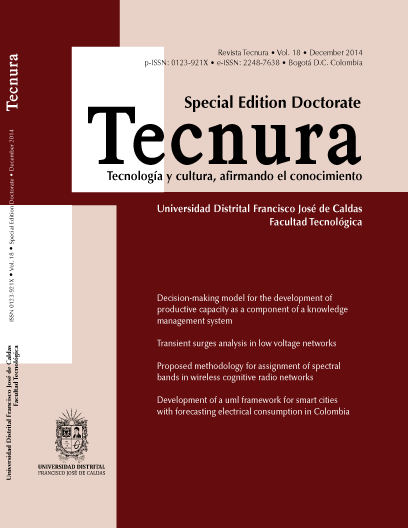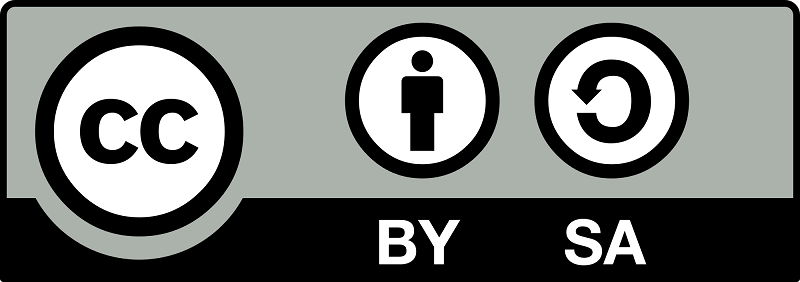DOI:
https://doi.org/10.14483/22487638.9243Publicado:
01-12-2014Número:
Vol. 18 (2014): Special Edition DoctorateSección:
InvestigaciónProposed methodology for assignment of spectral bands in wireless cognitive radio networks
Metodología propuesta para la asignación de bandas espectrales en redes de radio cognitivas inalámbricas
Palabras clave:
Cognitive radio networks, spectral decision making, proposal within conceptual diagram framework, licensed and non-licensed users (es).Palabras clave:
Cognitive radio networks, spectral decision making, proposal within conceptual diagram framework, licensed and non-licensed users. (en).Descargas
Resumen (en)
The article raises a proposal starting from the current state that improves the process of allocation of spectral bands at the decision-making stage in cognitive radio, decreasing the time that the system takes to select a channel to transmit data from unlicensed users, assuming the existence of free spectrum and estimating the behavior of the PUs and SUs.
Resumen (es)
El artículo plantea una propuesta a partir del estado actual que mejora el proceso de asignación de bandas espectrales en la etapa de toma de decisiones en la radio cognitiva, disminuyendo el tiempo que tarda el sistema en seleccionar un canal para transmitir datos de usuarios sin licencia, asumiendo la existencia de espectro libre y la estimación del comportamiento de las PU y SU.
Referencias
Shukla, A. et al. QinetiQ Ltd; 2007; Cognitive Radio Technology - A study for OFCOM. [En línea], consultado en Junio 10 de 2013, disponible en: http://enstakeholders.ofcom.org.uk/binaries/research/technologyresearch/cograd_main.pdf.
Federal Communications Commission, Spectrum policy task force report, Tech. Rep. ET Docket 02-155, 2010.
T. M. Taher, R. B. Bacchus, K. J. Zdunek, and D. A. Roberson, Long-term spectral occupancy findings in Chicago, in Proc. IEEE Int. Symp. Dynamic Spectr. Access Netw. Aachen, Germany, 2011.
J. Mitola, Q. Maguire, Cognitive radio: making software radios more personal, IEEE Pers. Commun., vol. 6, no. 4, pp. 13–18, Aug. 1999.
I.F. Akyildiz, L. Won-Yeol Lee, M.C. Vuran, S. A. Mohanty, A survey on spectrum management in cognitive radio networks, IEEE Communications Society, Communications Magazine, IEEE (Volume:46 , Issue: 4 ), pp. 40 – 48, April 2008
J. Mitola; Software radios - survey, critical evaluation and future directions, in Proceedings of the National Telesystems Conference (NTC 1992), pp. 13/15–13/23, Washington D.C, EE.UU, Mayo 1999.
Masonta, M., M.Mzyece., N. Ntlatlapa, Spectrum decision in cognitive radio networks: A Survey, IEEE Communications Society, Communications Surveys & Tutorials, Volume 15, Issue 3, pp.1088–1107, July (2013).
N. Bolivar; Medium access control messaging scheme for cognitive radio networks, Tesis Doctoral, Departamento de Computación, Arquitectura y Tecnología, Universidad de Girona, España, Junio 2012.
A. Goldsmith, S.A. Jafar, I. Maric, and S. Srinivasa, Breaking spectrum gridlock with cognitive radios: An information theoretic perspective, Proc. IEEE, vol. 97, no. 5, pp. 894–914, 2009.
IEEE 802.22, Working Group on Wireless Regional Area Networks, enabling Spectrum Sharing and Rural Broadband Wireless Access Using Cognitive Radio Technology in White Spaces, 2012. [En línea], consultado en Marzo 7 de 2014, disponible en: http://www.ieee802.org/22/.
Wang, J., M. Ghosh, K. Challapali, Emerging cognitive radio applications: a survey, IEEE Communications Magazine, Volume 49, Issue 3, pp. 74–81, March (2011).
Kolar, V., A. Gerco., T. Milcher., M. Petrova., P. Mahonen, Capacity estimation and adaptation in cognitive radio networks: Demonstrating software defined radios in action, International Conference on Mobile Computing and Networking (MobiCom), Beijing, pp. 20–25, September (2009).
Akyildiz, I., B. Lo., R. Balakrishnan, Cooperative spectrum sensing in cognitive radio networks: a survey, ElSevier, Physical Communications, Volume 4, Issue 1, pp. 40–62 (2011).
M. Vishram, C. Lau, Ch. Syin, K. Ashish, energy aware spectrum decision framework for cognitive radio networks, Electronic System Design (ISED), International Symposium on IEEE, Dec 19-22 , p.p. 309 – 313, Kolkata, 2012.
Derakhshani, M., T. Le-Ngoc, Learning-Based opportunistic spectrum access with adaptive hopping transmission strategy, IEEE Transactions on Wireless Communications, Volume 11, Issue 11, pp. 3957–3967 ( 2012).
Brah, F., I. Dayoub., L. Vandendorpe, Constrained resource allocation for OFDMA cognitive radio networks with primary users activity consideration, IEEE international symposium on wireless communication systems (ISWCS), pp. 766–770 (2012).
Working Group on Wireless Regional Area Networks, IEEE Standard 802.22, In Press, Corrected Proof Available online (2013).
Canberk, B., I. Akyildiz., S. Oktug, A QoS-aware framework for available spectrum characterization and decision in cognitive radio networks, IEEE 21st International Symposium Personal Indoor and Mobile Radio Communications (PIMRC), pp. 1533 –1538, September (2010).
Daoud, A., M. Alanyali., D. Starobinski, Secondary pricing of spectrum in cellular CDMA networks, IEEE Int. Symposium for New Frontiers in DySPAN, Dublin, Ireland, April 17–20 (2007).
Yarkan, S., H. Arslan, Binary time series approach to spectrum prediction for cognitive radio, IEEE Vehicular Technology Conference, Baltimore, USA, September/October, 30–3 (2007).
M. Vishram, C. Lau, Ch. Syin, K. Ashish, energy aware spectrum decision framework for cognitive radio networks, Electronic System Design (ISED), International Symposium on IEEE, Dec 19-22 , p.p. 309 – 313, Kolkata, 2012.
J. Hernández, E. Rodriguez, R. Marcelín, M. Pascoe, CRUAM-MAC: A novel cognitive radio MAC protocol for dynamic spectrum Access, IEEE Latin-America Conference on Communications (LATINCOM), Cuenca, Nov. 2012.
Cómo citar
APA
ACM
ACS
ABNT
Chicago
Harvard
IEEE
MLA
Turabian
Vancouver
Descargar cita
Licencia
Esta licencia permite a otros remezclar, adaptar y desarrollar su trabajo incluso con fines comerciales, siempre que le den crédito y concedan licencias para sus nuevas creaciones bajo los mismos términos. Esta licencia a menudo se compara con las licencias de software libre y de código abierto “copyleft”. Todos los trabajos nuevos basados en el tuyo tendrán la misma licencia, por lo que cualquier derivado también permitirá el uso comercial. Esta es la licencia utilizada por Wikipedia y se recomienda para materiales que se beneficiarían al incorporar contenido de Wikipedia y proyectos con licencias similares.


